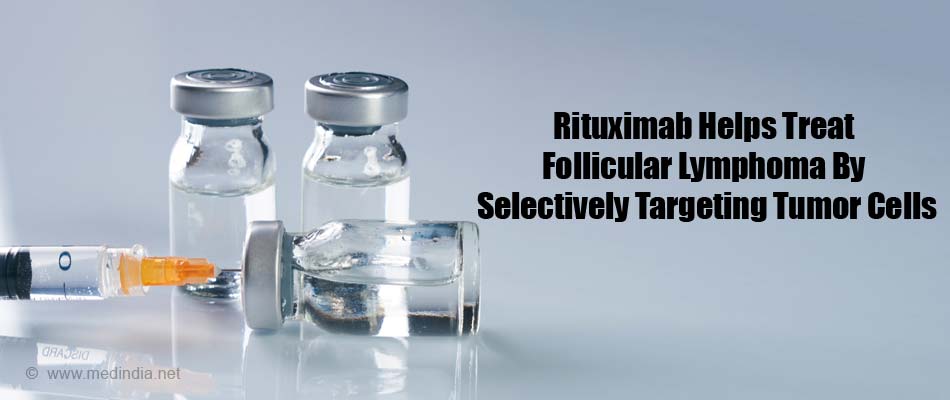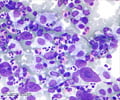- Follicular lymphoma - (http://www.leukaemia.org.au/blood-cancers/lymphomas/non-hodgkin-lymphoma-nhl/follicular-lymphoma)
- Follicular lymphoma: A guide for patients - (https://www.esmo.org/content/download/52236/963497/file/EN-Follicular-Lymphoma-Guide-for-Patients.pdf)
- Follicular lymphoma: 2015 update on diagnosis and management. Freedman A. Am J Hematol. 2015 Dec; 90(12):1171-8.
- Exploring Risk Factors for Follicular Lymphoma. Alexander J. Ambinder, Pareen J. Shenoy, Neha Malik, Alison Maggioncalda, Loretta J. Nastoupil, and Christopher R. Flowers. Advances in Hematology Volume 2012 (2012), Article ID 626035
- Pathology of Follicular Lymphoma. Katsuyoshi Takata, Tomoko Miyata-Takata, Yasuharu Sato, and Tadashi Yoshino. J Clin Exp Hematop Vol. 54, No. 1, June 2014
- Follicular lymphoma: evolving therapeutic strategies. Brad S. Kahl and David T. Yang. Blood, 28 April 2016, Vol. 127, No.17
- Primary follicular lymphoma of the duodenum Robbie L. Graham, MD, Mabel A. Mardones, MD, and John R. Krause. Proc (Bayl Univ Med Cent). 2015 Jul; 28(3): 381–383.
- Pediatric-type nodal follicular lymphoma: an indolent clonal proliferation in children and adults with high proliferation index and no BCL2 rearrangement Abner et al. Blood 2012 120:2395-2404
What is Follicular Lymphoma?
The two main forms of lymphoma are Hodgkin's lymphoma (HL) and non-Hodgkin’s lymphoma (NHL). Follicular lymphoma (FL) is the most common type of slow-growing non-Hodgkin's lymphomas, and the second-most-common form of non-Hodgkin's lymphomas, accounting for approximately 12% of all B-cell NHLs. It is known as "follicular" lymphoma because the abnormal B lymphocytes grow in lymph nodes in clusters to form nodules or follicles. Tumor cells are positive for the B-cell markers CD10, CD19, CD22, and CD20, but always negative for CD5.
What are the Types of Follicular Lymphoma?
Generally follicular lymphomas are slow growing or indolent but sometimes they undergo many transformation and start growing very fast and turn into high grade lymphomas and start behaving as diffuse large B-cell lymphoma which is a high grade lymphoma.
Based on the microscopic appearances, follicular lymphomas are graded as grade 1–2, grade 3A or grade 3B. The grade refers to how fast the lymphoma is likely to grow with higher grades showing faster rates of growth.
What are the Causes of Follicular Lymphoma?
The factors that cause follicular lymphoma are not known. It generally affects persons above 50 years of age, with the average age at diagnosis being 60 years. This type of cancer is more common in men than in women. Follicular lymphomas are not inheritable.
In some cases, radiation or cancer-causing chemicals such as hair dyes, pesticides, herbicides or certain infections, have been found to be associated with follicular lymphoma. A commonly noted mutation in FL involves translocation of DNA between chromosomes 14 and 18, or t (14;18) which turns on the bcl-2 oncogene leading to uncontrolled proliferation of B-cells.
Follicular lymphoma may be associated with the presence of abnormal immune system function and conditions such as HIV, rheumatoid arthritis, lupus, or celiac disease in which the immune system is affected.
What are the Symptoms of Follicular Lymphoma?
Patients may be asymptomatic. However the most common symptoms of FL include the following:
- Painless swelling or enlargement of the lymph nodes in the neck, armpit, abdomen or groin
- Constitutional symptoms such as tiredness, shortness of breath, weight loss, night sweats and high temperatures. The last three symptoms are known as B symptoms which are associated with both Hodgkin's and non-Hodgkin's lymphoma.

How do you Diagnose Follicular Lymphoma?
Diagnosis of follicular lymphoma involves a combination of history and physical examination, laboratory, radiologic and pathologic evaluations.
Physical examination: Generally, patients with FL have painless enlargement of superficial lymph nodes of small to medium size, which sometimes may not be noticed by the patient. Patients may also have B symptoms described above.
Laboratory blood tests: These tests include a complete blood count, serum lactate dehydrogenase (LDH) levels, and β2-microglobulin (β2M) levels. Serum LDH and β2-microglobulin are useful prognostic markers in malignant lymphomas.
Radiologic: Computed Tomography and PET scan will help in determining which parts of your body are affected and the stage of the lymphoma. Nowadays, a combination of two procedures, namely, PET-CT is performed using a small amount of a radioactive tracer, 18F-fluorodeoxyglucose (FDG), that is injected into the patient and becomes highly concentrated in lymphoma cells. PET-CT is more sensitive and specific than CT, and it also distinguishes viable tumor from scar or fibrosis. PET-CT is advisable as live tumor cells are avid for glucose and they will be able to retain the 18FDG glucose used in PET-CT. Hence, residual tumor cells will be detected by the PET camera and visualized.
Pathologic: Accurate diagnosis of follicular lymphoma can be made by a biopsy that can be performed in various ways:
- Excisional biopsy: It involves the removal of lymph node when the patient is under anesthesia and its histopathological examination in the laboratory looking for the presence of lymphoma cells.
- Core biopsy: If the lymph nodes are not easily accessible, a core biopsy is performed by removing only a part of a lymph node using a wide needle.
The removal of tissue or fluid using a thin needle (fine needle biopsy) is not recommended for a reliable lymphoma diagnosis.
Excisional biopsy is essential to avoid misdiagnosis, but if a lymph node is not easily accessible, core biopsy and fine-needle aspiration (FNA) biopsies along with other advanced techniques such as immunohistochemistry (IHC), flow cytometry, polymerase chain reaction (PCR), and fluorescence in situ hybridization (FISH) are done to determine the antigenic characteristics of the cancer cells and molecular changes that may be present.
As mentioned earlier, the lymphoma will be graded according to microscopic appearances with higher grade tumors considered to be faster growing.
How do you Treat Follicular Lymphoma?
The symptoms, the aggressiveness of the tumor, age and general health are the factors that determine the type of treatment to be given. The majority of people with FL have widespread disease when first diagnosed. The slow growing nature of these tumors make them less susceptible to standard forms of cancer treatments and so treatment is given to improve the symptoms such as progressively enlarging lymph nodes, weight loss, fever, night sweats and low blood counts.
Watch and wait: If patients are asymptomatic when they are diagnosed with FL, the treatment might not be given at first. In this case, the doctor usually suggests active monitoring, known as ‘watch and wait’.
Radiation therapy: Some patients with clinically early-stage (stage I or II) FL develop symptoms and they can be treated with radiation therapy alone. This uses high-energy beams to slow or stop the growth of cancer cells and is administered to the region of affected lymph nodes (called involved field radiation) or to the affected and nearby lymph nodes (called extended-field radiation).
Chemotherapy: This uses drugs to stop the growth of cancer cells either by killing the cells or by stopping them from dividing. Examples are Chlorambucil (Leukeran®), and Fludarabine. Combination chemotherapy provides treatment using two or more anticancer drugs.
Immunotherapy: The most common immunotherapy used is Rituximab, which is an antibody that selectively targets FL tumor cells. Following reduction in tumor size after Rituximab treatment, some patients with FL may choose to receive further treatments with Rituximab "maintenance therapy."

Chemoimmunotherapy: Though there are many treatment options for patients with advanced-stage disease, the choice of treatment depends upon the patient's preference and the need for the treatment. Generally, patients in this stage are given chemotherapy along with immunotherapy, sometimes called chemoimmunotherapy. Some of the chemoimmunotherapy regimens consist of:
- R-CVP is made up of Cyclophosphamide, Vincristine, Prednisolone and Rituximab.
- RCHOP is a combination of Cyclophosphamide, Hydroxydaunorubicin (also called Doxorubicin), Vincristine, Prednisolone and Rituximab.
- R-Bendamustine is made up of Bendamustine and Rituximab.
Radioimmunotherapy: It uses radioactive isotopes that are linked to monoclonal antibodies that are used to selectively treat only the cancer cells. Radioimmunotherapy treatment used for FL is 90 Y-Ibritumomab tiuxetan, which is given intravenously.
Stem cell transplantation: It is generally carried out in patients when lymphoma recurs after treatment and is carried out using either their own stem cells (autogeneic) or stem cells from a donor (allogeneic transplant).
Generally, in most patients, the follicular lymphoma relapses multiple times and so they are treated with novel targeted agents. These are small molecules designed to target signaling pathways that are abnormally expressed in the cancer cells. Example: Idelalisib is a novel agent used for the treatment of FL that has relapsed multiple times.
What are the Prognostic Factors for Follicular Lymphomas?
For prognosis of lymphomas, The International Prognostic Index (IPI) was developed which depends on 5 factors: age, stage of lymphoma, whether it is limited to one site or already spread, the person’s ability to do normal work and levels of serum lactate dehydrogenase (LDH that goes up with the amount of lymphoma). This index however did not consider the newer treatments available, so a revised IPI based on people with fast-growing lymphomas who have received modern treatment, including Rituximab was released.
This IPI is useful for most lymphomas but FL is slow growing, and so a new Follicular Lymphoma International Prognostic Index (FLIPI) was developed which uses different prognostic factors than the IPI. The good prognostic factors include age 60 years or below, stage I or II disease, blood hemoglobin levels-12g/dL or above, normal serum LDH and involvement of 4 or less lymph nodes.
The poor prognostic factors are age above 60 years, stage III or IV, blood hemoglobin that is less than 12 g/dL, high serum LDH and involvement of more than 4 lymph nodes. Each prognostic factor is assigned a point and persons without any poor prognostic factors would have a score of 0, while those with all poor prognostic factors would have a score of 5.
The overall survival rate of patients with follicular lymphoma is 72-77% at 5 years. Median survival was approximately 8-10 years. Patients who have four or more of the poor prognostic factors have a 10-year survival rate of approximately 36% (compared with 71% for those with one or none of these). All these are estimated survival rates and cannot predict an outcome. Due to recent new treatments, current survival rates have gone higher and recent reports for the period 1986 and 2012 estimates life expectancy of over 20 years.
How do you Prevent Follicular Lymphoma?
There is no known way to prevent follicular lymphoma. However, it is possible to reduce risk for the disease by avoiding some of the known risk factors:
- Sedentary lifestyle, decreased physical activity, obesity, diets high in meat and milk, as well as the presence of nitrates in the diet are associated with an increased risk to FL.
- Alcohol consumption is associated with an increased risk of FL. Tobacco, alcohol use, and obesity are all negatively associated with survival.
- Exposure to pesticides, hair dyes, industrial solvents such as xylene, benzene, styrene and chlorinated hydrocarbons, as well as proximity to industrial facilities such as petroleum refineries and metal industries have also been associated with the development of FL.
- Influenza vaccine, the use of β-blockers, and a history of heart disease are all positively associated with the development of FL.
- In addition to avoiding the risk factors, one should maintain a healthy life style with no smoking and drinking along with the consumption of plant based foods rich in antioxidants.
- Protective factors in the diet include fruits and vegetables, polyunsaturated fatty acids, and a variety of antioxidants. Some studies have shown that dietary vitamin D may act as a protective agent against FL.

Health Tips
- Avoid tobacco smoke as smoking increases the risk of many cancers and alcohol is associated with an increased risk of FL.
- Avoid exposure to pesticides, hair dyes, industrial solvents such as benzene, toluene, xylene, styrene, and chlorinated hydrocarbons.
- Avoid staying in proximity to industrial facilities such as petroleum refineries and primary metal industries.
- Achieve and maintain a healthy weight.
- Adopt a physically active lifestyle as immune function directly correlates with physical activity.
- Include protective factors in diet such as fruits and vegetables, polyunsaturated fatty acids and a variety of antioxidants.
- Include vitamin D in your diet and expose yourself daily to sunlight.







